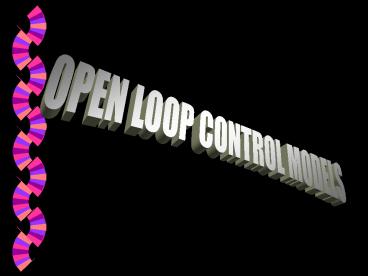OPEN LOOP CONTROL MODEL - PowerPoint PPT Presentation
1 / 27
Title:
OPEN LOOP CONTROL MODEL
Description:
Movements within that class have same relative timing ... DIFFERENT PATTERNS OF ABILITIES WITH DIFFERENT PATTERNS OF STRENGTH AND WEAKNESS ... – PowerPoint PPT presentation
Number of Views:181
Avg rating:3.0/5.0
Title: OPEN LOOP CONTROL MODEL
1
(No Transcript)
2
OPEN LOOP CONTROL MODEL
- SAME AS CLOSED LOOP EXCEPT
- NO FEEDBACK
- NO COMPARATOR
3
MOTOR PROGRAM
- EVIDENCE FOR
- RT AND MOVEMENT COMPLEXITY
- DEAFFERENTATION EXPERIMENTS
- BLOCKING A MOVEMENT
4
Kovar, S., Overdorf, V. (1996). Scholarship
redefined Changing contexts in the
professoriate. Quest, 48(2), 211-220.
5
SPINAL GENERATOR MODEL FOR GAIT
HIGHER CENTERS
FLEXORS
EXTENSORS
SENSORY INPUT
6
PROBLEMS WITH ORIGINAL MOTOR PROGRAM CONCEPT
- STORAGE PROBLEM
- NOVELTY PROBLEM
7
GENERALIZED MOTOR PROGRAM
8
MODULATION OF MOTOR PROGRAM OUTPUT
- VARIATION IN MOVEMENT TIME
- VARIATION IN MOVEMENT AMPLITUDE
- VARIATION IN LIMB USED
9
INVARIANT FEATURES AND PARAMETERS
10
INVARIANCE
- RELATIVE TIMING
- CLASSES OF MOVEMENTS
- Has particular relative timing
- Movements within that class have same relative
timing - Movements in different classes have different
relative timing
11
SHAPIRO ET AL STUDY
- 3-6 KM/HR
- E3 48
- F 10
- E2 10
- E1 28
- 1 GMP
- WALKING
- 8-12 KM/HR
- E3 28
- F 25
- E2 15
- E1 32
- 1 GMP
- RUNNING
12
GMP
- Underlies class of movements and structured in
memory with rigidly defined temporal
organization. - Structure characterized by relative timing, a set
of ratios among the duration of various events in
the movement. - Variations in MT, MA, and limb used represent
movements surface structure, adjusted with
different parameters relative timing represents
deep structure.
13
GMP (cont)
- Movement may be carried out with different
surface features (e.g., duration, amplitude),
relative timing remains invariant. - Surface features are easy to alter by parameter
adjustment deeper relative timing structure is
far more difficult to alter.
14
WHAT MUST BE SPECIFIED IN THE PROGRAM?
- Muscles that must participate in the action
- Order of contraction of the involved muscles
- Amount of force output that is necessary
- Relative timing and sequencing among contractions
- Duration of each contraction
15
PROGRAMS CONTRIBUTIONS TO ACTIONS
- POSTURAL ADJUSTMENTS
- CENTRAL PATTERN GENERATORS
- INTEGRATION OF CENTRAL CONTROL AND FEEDBACK
CONTROL - REFLEX REVERSAL
- ENHANCING FLEXIBILITY OF MOVEMENT
16
SPEED/ACCURACY TRADEOFF
17
MOVEMENT SPEED AND MOVEMENT DISTANCE
A
W
W
FITTS LAW
SPEED ACCURACY TRADEOFF
18
FITTS LAWAverage movement time increases as
movement amplitude increases and target width
decreases.
19
EXPERIMENTAL APPROACH VSDIFFERENTIAL APPROACH
20
DISTINCTIONS BETWEEN ABILITIES AND SKILLS
- SKILLS
- Developed with practice
- Modified with practice
- Countless in number
- Depend on several abilities
- AB ILITIES Inherited traits
- Stable and enduring
- Perhaps 50 in number
- Underlie many different skills
21
GENERAL MOTOR ABILITY
22
CONCLUSIONS BASED ON CORRELATION ANALYSIS
- CORRELATIONS AMONG DIFFERENT SKILLS ARE GENERALLY
VERY LOW - EVEN SKILLS THAT APPEAR QUITE SIMILAR USUALLY
CORRELATE POORLY. - THIS OVERALL LACK OF CORRELATION AMONG SKILLS
ARGUES AGAINST THE CONCEPT OF A GENERAL MOTOR
ABILITY. - ON THE OTHER HAND, TWO SKILLS WITH ONLY MINOR
DIFFERENCES CAN CORRELATE STRONGLY.
23
ASSUMPTIONS OF SPECIFICITY VIEW
- VERY MANY ABILITIES EXIST
- THESE ABILITIES ARE NOT RELATED TO EACH OTHER
THEY ARE SPECIFIC - A GIVEN SKILL IS SUPPORTED BY MANY OF THESE
ABILITIES - DIFFERENT SKILLS HAVE DIFFERENT PATTERNS OF
ABILITIES WITH DIFFERENT PATTERNS OF STRENGTH AND
WEAKNESS
24
Superability
Motor abilities
RT
RO
S.M.
PP
MD
RI
FD
25
INVOLVEMENT OF ABILITIES IN SKILL PRODUCTION
- Any given skill is contributed to by several
fundamental motor abilities - Some of the abilities underlying a skill play
very dominant roles, while others have weaker
roles - Two different skills have different patterns of
underlying abilities - Two different skills can have a few abilities in
common.
26
CLASSIFICATION PERMITS
- The application of appropriate learning
principles to activities - Giving the learner added assistance in factors
that should be emphasized for effective movement
control - Selecting individuals for advanced training based
on abilities that relate to task.
27
PREDICTION INVOLVES FOLLOWING COMPONENTS
- Understanding abilities that underlie the
criterion task - Estimating strength of these abilities as
indicators of future capabilities in the
criterion task - Estimating future (potential) skill level on some
criterion task based on present information

